Scholz Research & Development, Inc.
Scholz Research & Development, Inc. or SR&D is the name of the company founded by musician and engineer Tom Scholz to design and manufacture music technology products. Scholz was an MIT-trained engineer who developed many of his skills working on audio-production equipment as a product design engineer at Polaroid in the early 1970s. A musician in his off-time, he developed a recording studio in the basement of the apartment building where he lived, utilizing many home-built devices. Recordings made in his home studio later became the debut album of the band Boston, while the Scholz's proceeds from the success of his band were used to found the company to further develop and sell market versions of his inventions. Many of the devices were marketed under the Rockman brand.
The manufacturing facility was located in Woburn, Massachusetts, in the 1980s.
History
The "Boston guitar sound" was the result of Scholz's endless experimentation with guitar amplifiers, microphones, equalizers, and other gear. Modified equipment, which was the result of much of this experimentation, inspired some one-of-a-kind products that Scholz felt other guitarists would find useful. Thus, SR&D was founded in 1980.
In 1982, the company developed and released the Rockman headphone guitar amplifier, designed to allow full amplifier-type sounds to be output through a standard headphone jack, thus allowing musicians to practice through headphones or through a home stereo system.
Later on, SR&D added other signal processing equipment to their product line, notably the Rockmodules, which were half-rack effects that modularized individual components of the Rockman. Guitar amplifiers and other gear were also produced.
The Rockman line, which used analog circuits, became less successful during the digital effects boom of the early 1990s, essentially putting the company out of business. Today, some SR&D products are highly collectible.
In 1995, Scholz sold the Rockman line to Dunlop Manufacturing, Inc. and closed SR&D.
Products
Power Soak
The first product released by SR&D was not called a Rockman. It was simply called "Tom Scholz's Power Soak". The Power Soak is an attenuator, put inline between an amplifier and its speakers. The Power Soak can be used to limit the output level while still maintaining the desired overdriven, saturated sound of an amplifier running at full volume. The first commercial Power Soak was issued at the end of 1980. An updated version of the Power Soak, the Model II, was issued at the end of 1981. It has an extra switch made to adapt the Power Soak to solid-state amplifiers. The Power Soak was re-issued in 1992 as a Power Soak model III, lacking the solid-state switch, though the Power Soak III can be used both with solid-state and tube amps. The jacks were also moved to the back of the unit.
Headphone amplifiers
The Rockman brand name was inaugurated with the first of the headphone amplifiers. The original Rockman combined multiple effects, portability, along with quality components and construction. It was marketed as a headphone amplifier but allowed the guitarist to plug directly into the mixer on the stage and in the studio. This effectively made the Rockman a DI unit for many guitarists.[1] An example of this is when Def Leppard used the Rockman in the making of their album Hysteria.[2]
Rockman
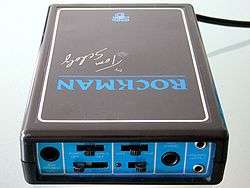
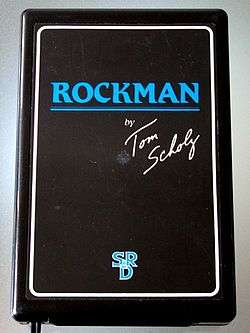

The original Rockman was released in 1982. It includes an amplifier simulator, stereo chorus and echo. It has two clean sounds, along with "Edge" and distortion modes. The two clean modes are differently EQ'd, "Clean 1" targets the electric guitar, while "Clean 2" is recommended for a wider range of use, including acoustic guitar, keyboard and vocals. The "Edge" setting produces what is described as "subtle" distortion, that will clean up when playing softly. The chorus and echo are tied together, both being on when the switch was set to normal. The chorus or echo can be disabled, but not both at the same time. The Rockman requires eight AA batteries or an adapter for power. The name 'Rockman' has similarity to Sony's 'Walkman' which had been introduced to the US in 1980, with both devices being breakthroughs in portable stereophonic electronics.
Rockman Ultralight
Production of the Rockman Ultralight began in 1983. It was a more economical alternative to the Rockman. It is very similar to the Rockman but lacks the echo. Uniquely, the chorus can be disabled, providing a dry output from the amplifier simulator. Both the original Rockman and Ultralight models were discontinued in 1984.
X100, Soloist, Bass Rockman
A new series of Rockman products was introduced in 1984, which included the X100, Soloist and Bass Rockman. These continued to be produced until 1994. The X100 is very similar to the original Rockman in its feature set, but uses a different clipping stage in the amplifier simulation.
The Rockman Soloist was positioned as a lower cost Rockman product. It does not have the "Clean 2" voice. It also has different choices for effects, including a setting for chorus and a "stereo" setting that has a fixed 25-millisecond delay. It can be set to "Mono" output, removing all the effects.
The Bass Rockman features clean and distortion modes that include chorus. Dry output is available when the chorus switch is set to "off". There are three EQ presets for what is described as "Fat", "Mid" and "Bright". There is a high frequency clipper, recommended for use with a pick or "snapping" the strings. There is a high frequency compressor and sustain switch, primarily intended for changing the sustain of the bass in different ways.
Ace family
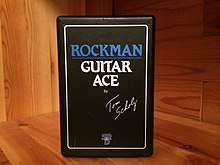
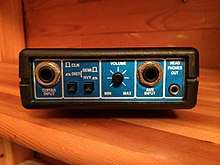


The Ace family is a much simpler type of Rockman that does not have effects and uses a single 9-volt battery or power supply. The Guitar and Bass Ace were first released in 1990. The Metal Ace was released in 1994. The Guitar Ace and Metal Ace have identical controls, but the Metal Ace is advertised to have a "brighter" sound. The amplifier distortion is toggled using the "cln/dist" button. The character of the distortion can be changed with the "semi/hvy" button. Semi-distortion behaves much like the "edge" setting is described to, in the Rockman and X100 product. The Bass Ace has the most spartan controls, including mid and treble boost buttons.
Complete model listing
The Rockman was originally produced by SR&D. The Ace family is still produced by Dunlop.[3][4]
SR&D
- Rockman
- Ultralight
- X100
- Soloist
- Bass Rockman
- Rockman X100 10th Anniversary
- Rockman or X100 with Rockmax modification
- Guitar Ace
- Metal Ace
- Bass Ace
Dunlop
- Guitar Ace
- Metal Ace
- Bass Ace
Rockmodules
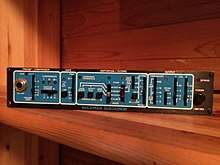
The Rockmodules are a line of professional-quality, rack-mount guitar effects, introduced in 1986. There are roughly three categories of Rockmodules, the amplifier simulators, the sound processors and the control devices.
Amplifier simulators
The amplifier simulators include the Sustainor and Distortion Generator. They are the basic building blocks for creating a Rockman system. Systems built from the Sustainor or Distortion Generator are primarily intended for direct connection to a full-range PA system.
The Sustainor was first released in 1986. The Sustainor includes a preamp/compressor, a noise gate, distortion and filters, along with a cabinet simulation. Another feature is the auto-clean circuit that allows controlling the guitar distortion by adjusting the guitar volume knob. The Distortion Generator is a related product that was released in 1987. The Distortion Generator includes compression, distortion and cabinet simulation circuitry. Compared to the Sustainor, the Distortion Generator lacks the noise gate and external loop, but includes a three-band pre-distortion EQ.
Sound processors
The sound processors include the EQ, Compressor, Smart Gate, Chorus, Echo and Stereo Chorus/Delay. The Stereo Chorus/Delay was released first in 1986. It can be used as either a chorus or delay. The chorus effect can be mono or stereo. The Chorus/Delay is used for doubling, slap-back and reverb-like short echoes. Combining the Stereo Chorus/Delay with a Sustainor provides a complete system for recording guitar. 1987 brought the Instrument EQ, Stereo Echo and Stereo Chorus.
The Instrument EQ was specifically designed for use with the Sustainor and Distortion Generator. The EQ frequencies were tailored for use with musical instruments, putting an emphasis on the mid-range frequencies. Its intended place in a Rockmodule lineup is after the Sustainor or Distortion Generator, but before the chorus and echo effects. It can also be used as a pre-distortion EQ, when placed in the Sustainor effects loop.
The Rockman Stereo Echo is an analog delay. It can be used to provide "slap back" echo when no feedback is used. Increasing the delay time and adding feedback provides standard echo effects. It has stereo inputs, or a mono input if only the left input is used. One possible lineup is to put the Stereo Echo after the Stereo Chorus. The Stereo Chorus was introduced in 1987, following the Stereo Chorus/Delay in the Rockmodule lineup. It is a dedicated analog chorus and adds foot-switchable controls for long-chorus and sweep stop.
The Rockman Guitar Compressor is a professional quality compressor tailored for use with guitars. Since many of the Rockman products include a compressor (Headphone amps, Sustainor, Distortion Generator, XP Series, Acoustic Guitar Pedal and Ultimatum based products), this effect is primarily intended to add compression when it is not provided by other equipment in the signal chain. The Rockman Smart Gate is a dedicated noise gate that builds on the noise gate technology in the Rockman Sustainor.
Control devices
The control devices include the Midi Octopus and Dual Remote Loop. The Midi Octopus is used for controlling other effects. It could be used with a Midi pedal board, or be controlled by a Midi sequencer. The Dual Remote Loop is used to interface effects and amplifiers that can't controlled by other means.
XP series
The XP series started in 1989 as a rack-mounted programmable preamplifier called the XPR that was intended for direct connection to a full-range PA system. There is a three-band EQ that allows pre-distortion changes to the EQ. The clean signal can also be mixed with the distorted signal. The distortion is followed by a second 5 band EQ. The effects follow, including a stereo chorus that has a programmable sweep speed, along with a reverb.
XP 100 combo
The release of the XPR in 1989 was complemented by the release of the related XP100. The XP100 is a complete amplifier that packages the XPR pre-amplifier with a 2x50-Watt stereo amplifier and 6-inch speakers. The speakers are in a dual enclosure that can be separated.
1991 models
1991 brought a number of XP series products, that were all produced in small numbers. A low-noise update to the XPR was released, called the XPRa. Similarly, the XP100a combo was released as a low-noise version of the XP100. Another combo was released in 1991. Instead of 6-inch speakers like the XP100 and XP100a, 12-inch speakers were installed, in a 2x12 single-cabinet configuration. This product was called the XP212. A head version was also produced, called the Rockman Superhead. It is basically a XP100, without the speakers. Due to the small production numbers, the XPRa, XP100a, XP212 and Superhead are extremely difficult to find in the aftermarket.
Rockman Guitar Monitor
The Rockman Guitar Monitor is a Guitar Stack that can be used with the Rockmodules or XPR. It was introduced in 1991. The components include a Rockman PA500 amplifier (a modified Carver PM175 2x250-Watt), up to four linear 3-way cabinets and stage head that provides mounting for the amp, pre-amp and other rack-mount components.
Studio Series
The Studio Series consists of two 19-inch rack-mount systems that were both briefly built in 1991. This includes the Pro Bass Rockman and PGE-2 two-channel programmable equalizer. Only around 20 of the Pro Bass Rockman were made. Just ninety-nine PGE-2's were made.
Pro Bass Rockman
The Pro Bass includes compression and a 9-band graphic equalizer. A foot-switchable 3-band equalizer can also be used to change the EQ during a performance. It has an onboard stereo chorus, overdrive, tape input, tuner output and headphone output.
PGE 2
The PGE 2 is a 1U rack-mount, two-channel, MIDI programmable graphic equalizer. It includes two complete 14 band graphic equalizers and input/output overload indicators. The controls are fully programmable with up to 100 presets.
Final products
Ultimatum
The Ultimatum products are based on two distinct clipping stages in series. The first part of the Ultimatum circuit has a compressor, clipping stage and cabinet simulation. A second clipping stage simulates the saturation of a power section in an overdriven tube amplifier. Both the A12-50 combo and Ultimatum distortion generator are based on this circuit.
A12-50 combo
The A12-50 combo was released in 1993. It is a two-channel (distortion and clean) 1x12 50-Watt mono combo. It lacks the chorus and reverb of the other Rockman products, but provides an effects loop for using external effects. It is probably the most conventional of the Rockman guitar amplifiers.
Ultimatum distortion generator
The Ultimatum Distortion Generator was introduced in 1994. It was designed primarily for use as a distortion with a standard guitar amplifier. It can also be used as a pre-amplifier for directly connecting a guitar to a mixing console.
Acoustic guitar pedal
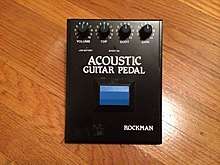
The Acoustic Guitar Pedal was released in 1994, designed for clean guitar work. It is basically a compressor with bass and treble controls. It is intended to make an electric guitar sound more like an acoustic guitar. The Acoustic Guitar Pedal was produced by SR&D and Dunlop. The SR&D version can be identified by its grey button. The Dunlop version has a blue button.
References
- "SR&D The Rockman revolution". rockman.fr. Retrieved 9 February 2013.
- "Interview: Phil Collen on the Making of Def Leppard's 'Hysteria' (Page 2)". guitarworld.com. Retrieved 10 February 2013.
- "Rockman Headphones Amps". rockman.fr. Retrieved 8 February 2013.
- "SR&D Rockman product list". rockman.fr. Retrieved 8 February 2013.